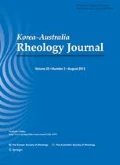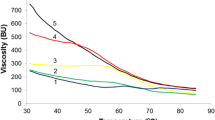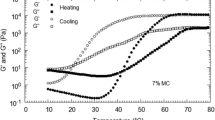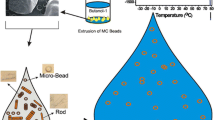Abstract
In this study, the thermo-gelation behavior of hydroxypropyl methylcellulose (HPMC) and hydroxyethyl methylcellulose (HEMC) were examined by rheology. Temperature sweep shear viscosity measurements revealed a significant decrease in the shear viscosity of HPMC and HEMC at the aggregation temperature (Tagr), which depended on the substitution type (HPMC or HEMC) and degree of substitution. In the dynamic test, G′ decreased slightly at Tagr and increased significantly at the gelation temperature (Tgel). The shear viscosity and shear storage modulus (G′) can be utilized complementarily to examine Tagr and Tgel. Tagr could be detected clearly by the shear viscosity measurement but could not be observed in the G′ measurement. On the other hand, Tgel could not be detected in the shear viscosity measurement although it can be clearly recognized in G′ measurement. Conclusively, the two rheological measurements could be utilized complementarily in detection of Tagr and Tgel. In the meanwhile, HPMC with more hydrophobic residues (methoxy and hydroxypropyl residues) showed smaller Tagr and Tgel than HEMC, which has hydroxyethyl and methoxy groups. Tagr and Tgel decreased with increasing number of hydrophobic groups. Molecular weight almost did not affect Tagr and Tgel of HPMC solution.
Similar content being viewed by others
References
Bain, M.K., M. Bhowmik, S.N. Ghosh, and D. Chattopadhyay, 2009, In situ fast gelling formulation of methyl cellulose for in vitro ophthalmic controlled delivery of ketorolac tromethamine, J. Appl. Polym. Sci. 113, 1241.
Bajwa, G.S., C. Sammon, P. Timmins, and C.D. Melia, 2009, Molecular and mechanical properties of hydroxypropyl methylcellulose solutions during the sol:gel transition, Polymer 50, 4571.
Ban, S.J., C. W. Rico, I.C. Um, and M.Y. Kang, 2012a, Comparative evaluation of the hypolipidemic effects of hydroxyethyl methylcellulose (HEMC) and hydroxypropyl methylcellulose (HPMC) in high fat-fed mice, Food Chem. Toxicol. 50, 130.
Ban, S.J., C.W. Rico, I.C. Um, and M.Y. Kang, 2012b, Antihyperglycemic and antioxidative effects of hydroxyethyl methylcellulose (HEMC) and hydroxypropyl methylcellulose (HPMC) in mice fed with a high fat diet, Int. J. Mol. Sci. 13, 3738.
Bhowmik, M, S. Das, J. Sinha, S. Bag, D. Chattopadhyay, and L.K. Ghosh, 2010, Methyl cellulose based sustained release thermosensitive in situ fast gelling ocular delivery of ketorolac tromethamine, Asian J. Chem. 22, 2147.
Blouin, S, M.F. Moreau, P. Weiss, G. Daculsi, M.F. Basle, and D. Chappard, 2006, Evaluation of an injectable bone substitute (beta TCP/hydroxyapatite/hydroxy-propyl-methyl-cellulose) in severely osteopenic and aged rats, J. Biomed. Mater. Res. Part A 78A, 570.
Bodvik, R., A. Dedinaite, L. Karlson, M. Bergstrom, P. Baverback, J.S. Pedersen, K. Edwards, G. Karlsson, I. Varga, and P.M. Claesson, 2010, Aggregation and network formation of aqueous methylcellulose and hydroxypropylmethylcellulose solutions, Colloid Surf. A-Physicochem Eng. Asp. 354, 162.
Campos-Aldrete, M.E. and L. Villafuerte-Robles, 1997, Influence of the viscosity grade and the particle size of HPMC on metronidazole release from matrix tablets, Eur. J. Pharm. Biopharm. 43, 173.
Chen, Y.H., M. Zhang, W.T. Liu, and G.Y. Li, 2011, Properties of alkali-solubilized collagen solution crosslinked by N-hydroxysuccinimide activated adipic acid, Korea-Aust. Rheol. J. 23, 41.
Chirico, S., A. Dalmoro, G. Lamberti, G. Russo, and G. Titomanlio, 2007, Analysis and modeling of swelling and erosion behavior for pure HPMC tablet, J. Control. Release 122, 181.
Dow Chemical Company, 2002, Methocel cellulose ethers technical handbook, Dow Chemical Company. http://msdssearch.dow.com/PublishedLiteratureDOWCOM/dh_004f/0901b8038004fa1b.pdf?filepath=methocel/pdfs/noreg/192-01062.pdf&fromPage=GetDoc
Ferry, J.K., 1980, Viscoelastic properties of polymers, 3rd edn. Wiley, New York.
Hussain, S., C. Keary, and D.Q.M. Craig, 2003, A thermorheological investigation into the gelation and phase separation of hydroxypropyl methylcellulose aqueous systems, Polymer 43, 5623.
Hyun K., H.T. Lim, and K.H. Ahn, 2012, Nonlinear response of polypropylene (PP)/Clay nanocomposites under dynamic oscillatory shear flow, Korea-Aust. Rheol. J. 24, 113.
Kita, R., T. Kaku, K. Kubota, and T. Dobashi, 1999, Pinning of phase separation of aqueous solution of hydroxypropylmethylcellulose by gelation, Phys. Lett. A 259, 302.
Kobayashi, K., C.L. Huang, and T.P. Lodge, 1999, Thermoreversible gelation of aqueous methylcellulose solutions, Macromolecules 32, 7070.
Liu, S.Q., S.C. Joshi, and Y.C. Lam, 2008a, Effects of salts in the Hofmeister series and solvent isotopes on the gelation mechanisms for hydroxypropylmethylcellulose hydrogels, J. Appl. Polym. Sci. 109, 363.
Liu, S.Q., S.C. Joshi, Y.C. Lam, and K.C. Tam, 2008b, Thermoreversible gelation of hydroxypropylmethylcellulose in simulated body fluids, Carbohyd. Polym. 72, 133.
Maki, K.C., M.H. Davidson, K.C. Malik, H.H. Albrecht, J. O’Mullane, and B.P. Daggy, 1999, Cholesterol lowering with high-viscosity hydroxypropylmethylcellulose, Am. J. Cardiol. 84, 1198.
Plank, P., 2003, Applications of biopolymers in construction engineering. In: Steinbuechel A (ed) Biopolymers, Wiley-VCH, Weinheim, 29–95.
Pouchez, J., A. Peschard, P. Grosseau, R. Guyonnet, B. Guihot, and F. Vallee, 2006, HPMC and HEMC influence on cement hydration, Cem. Concr. Res. 36, 288.
Sarkar, N., 1979, Thermal gelation properties of methyl and hydroxypropyl methylcellulose, J. Appl. Polym. Sci. 24, 1977.
Silva, S.M.C., F.V. Pinto, F.E. Antunes, M.G. Miguel, J.J.S. Sousa, and A.A.C.C. Pais, 2008, Aggregation and gelation in hydroxypropylmethyl cellulose aqueous solutions, J. Colloid Interf. Sci. 327, 333.
Uslu, I. and A. Aytimur, 2012, Production and characterization of poly(vinyl alcohol)/poly(vinylpyrrolidone) iodine/poly(ethylene glycol) electrospun fibers with (hydroxypropyl)methyl cellulose and aloe vera as promising material for wound dressing, J. Appl. Polym. Sci. 124, 3520.
Wang, Q.Q. and L. Li, 2005, Effects of molecular weight on thermoreversible gelation and gel elasticity of methylcellulose in aqueous solution, Carbohyd. Polym. 62, 232.
Williams, R.O., T.D. Reynolds, T.D. Cabelka, M.A. Sykora, and V. Mahaguna, 2002, Investigation of excipient type and level on drug release from controlled release tablets containing HPMC, Pharm. Dev. Technol. 7, 181.
Yoon, D.S., Y.K. Cho, K.W. Oh, S. Kim, Y.A. Kim, J.I. Han, and G. Lim, 2006, A microfluidic gel valve device using reversible sol-gel transition of methyl cellulose for biomedical application, Microsyst. Technol. 12, 238.
Author information
Authors and Affiliations
Corresponding author
Rights and permissions
About this article
Cite this article
Yoo, Y.J., Um, I.C. Examination of thermo-gelation behavior of HPMC and HEMC aqueous solutions using rheology. Korea-Aust. Rheol. J. 25, 67–75 (2013). https://doi.org/10.1007/s13367-013-0007-8
Received:
Revised:
Accepted:
Published:
Issue Date:
DOI: https://doi.org/10.1007/s13367-013-0007-8




